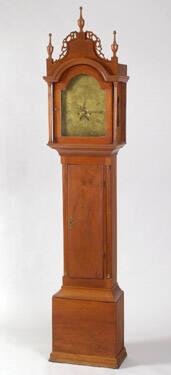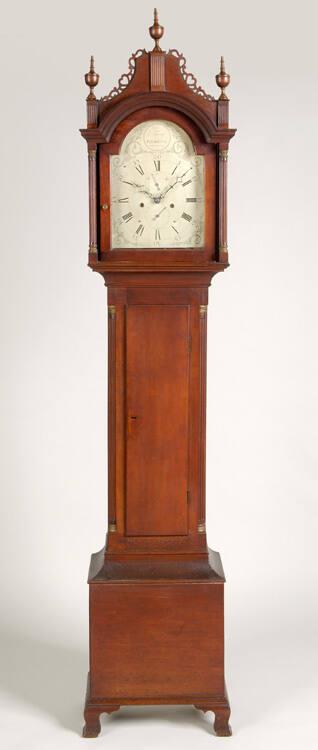Tall Case Clock
ClockmakerClock works made by
Eli Terry
(American, 1772 - 1852)
Furniture MakerMade by
Unknown
Date1800
MediumCase: Cherry primary wood.
Dial: Brass.
Works: Cast brass and iron.
DimensionsPrimary Dimensions (overall height x width x depth): 89 3/4 x 19 3/16 x 10 1/4in. (228 x 48.7 x 26cm)
ClassificationsClocks
Credit LineGift of Kenneth D. Roberts
Object number1980.55.0
DescriptionTall case clock in the Chippendale, or rococo, style, with a cherry case, a pagoda pediment with fretwork panels at the top of the arched hood, a brass clock movement, and a brass dial that is engraved "E. Terry/ Plymouth". The tall case clock consists of three major components: the removable hood, the removable dial and clock works, and the clock case. The dial and works sit on a horizontal board at the top of the clock case; the pendulum and weights (all separated from the clock) that drive the works would be suspended in the trunk, or narrow body, of the case. The hood slides over the works and sits at the top of the case.
At the top of the hood are three turned, cherry finials, each consisting of a slender cone atop an urn. Each finial sits at the top of a square plinth. The pagoda-shaped pediment consists of a panel of wood that arches in the center, then abruptly slopes down to meet the base of each side plinth. The top edge of the pediment has fretwork in the shape of scrolls. The front of the hood has a glass door that is arched and recessed, with a small brass knob at the left side. The door is flanked by a fluted, free-standing column. Each side of the hood has a rectangular glass window with a rounded top. The trunk of the clock case has deep cove, or recessed quarter-circle, molding at the top and bottom; a wide, rectangular door on the front; and fluted quarter columns at each front corner. All four sides of the door are edged with incised bead molding. The rectangular base of the clock case has projecting, stepped base molding at the front and sides.
Construction Details: A single, vertically-oriented backboard with an arched top edge extends the full height of the hood and case. The hood does not have a back; it slides over the clock works to rest on the cove molding at the top of the trunk. The hood is constructed of a three-part frame, with a top and two sides that are joined with a nailed butt joint at the top corners. All ornament is nailed or glued to this frame: the pagoda pediment with fretwork, the plinths, the projecting arched molding at the front of the hood, and the projecting panels and molding at the top sides of the hood. A rectangular window is cut out of each side of the hood. The sides of the hood attach to a horizontal, three-sided frame with molding at the outside edges. Each free-standing column extends between the projecting molding at the top of the hood and the horizontal, three-sided frame at the bottom. The door is constructed of wooden rails that are tenoned at each corner. The door pivots on a pair of brass hinges at the top right and bottom right corner.
The backboard is nailed into a rabbet on each back corner of the sides of the trunk. The boards that form the sides of the trunk extend several inches above the bottom of the hood. The clock works rest on a seat board, or horizontal board immediately behind the dial. The seat board rests on the top edge of each side of the trunk. The cove molding is nailed to the front and sides of the top and bottom of the trunk. There is a rail above and below the door, and a vertical post at each front corner of the trunk that forms the carved quarter column. Large, vertical glue blocks join the front to the sides of the trunk. The door is constructed of a single board that is joined to the trunk with two brass hinges at the right side; there is a brass lock escutcheon on the center left side (the lock is missing). The sides of the trunk extend down to the top of the base. The front and sides of the base are each joined with a nailed butt joint at the front corners. The bottom board is nailed to the underside of the base sides. The base molding is nailed to the front and sides of the base.
Dial: The engraved, brass dial is square with an arched top; it would have been silvered originally. The center of the dial arch is engraved "E. Terry/ PLYMOUTH" inside an oval wreath. There is a small flower to either side of the wreath. The middle of the square dial plate is engraved with a chapter ring, consisting of a ring of Roman numerals, inside a ring of minute gradations, inside a ring of Arabic numbers from one to sixty in increments of five. In the center of the chapter ring is an arbor, or axle, around which the hour and minute hands pivot. To either side of the main arbor is a winding arbor, to wind the clock. A round seconds dial is engraved above the main arbor, with a hand pivoting around the center. A round calendar dial is engraved below the main arbor, with a hand pivoting around the center. A semi-circular arch is pierced through the interior top of the calendar dial. Additional scroll and floral designs are engraved in each corner of the dial plate.
Clock Works
Movement: weight powered, key wound
Duration: eight day
Materials: cast brass
Strike: rack and snail
Escapement: recoil
The works have bulbous pillars. The works are accompanied by a pendulum and a pair of cylindrical weights.
Condition: The left side of the hood is split, and the glass is broken in the window on that side. There are multiple nail or screw holes through the backboard. There are two holes pierced through the bottom of the case. The silver has worn off the brass dial. The pendulum and a pair of cylindrical weights are separated from the clock works.
At the top of the hood are three turned, cherry finials, each consisting of a slender cone atop an urn. Each finial sits at the top of a square plinth. The pagoda-shaped pediment consists of a panel of wood that arches in the center, then abruptly slopes down to meet the base of each side plinth. The top edge of the pediment has fretwork in the shape of scrolls. The front of the hood has a glass door that is arched and recessed, with a small brass knob at the left side. The door is flanked by a fluted, free-standing column. Each side of the hood has a rectangular glass window with a rounded top. The trunk of the clock case has deep cove, or recessed quarter-circle, molding at the top and bottom; a wide, rectangular door on the front; and fluted quarter columns at each front corner. All four sides of the door are edged with incised bead molding. The rectangular base of the clock case has projecting, stepped base molding at the front and sides.
Construction Details: A single, vertically-oriented backboard with an arched top edge extends the full height of the hood and case. The hood does not have a back; it slides over the clock works to rest on the cove molding at the top of the trunk. The hood is constructed of a three-part frame, with a top and two sides that are joined with a nailed butt joint at the top corners. All ornament is nailed or glued to this frame: the pagoda pediment with fretwork, the plinths, the projecting arched molding at the front of the hood, and the projecting panels and molding at the top sides of the hood. A rectangular window is cut out of each side of the hood. The sides of the hood attach to a horizontal, three-sided frame with molding at the outside edges. Each free-standing column extends between the projecting molding at the top of the hood and the horizontal, three-sided frame at the bottom. The door is constructed of wooden rails that are tenoned at each corner. The door pivots on a pair of brass hinges at the top right and bottom right corner.
The backboard is nailed into a rabbet on each back corner of the sides of the trunk. The boards that form the sides of the trunk extend several inches above the bottom of the hood. The clock works rest on a seat board, or horizontal board immediately behind the dial. The seat board rests on the top edge of each side of the trunk. The cove molding is nailed to the front and sides of the top and bottom of the trunk. There is a rail above and below the door, and a vertical post at each front corner of the trunk that forms the carved quarter column. Large, vertical glue blocks join the front to the sides of the trunk. The door is constructed of a single board that is joined to the trunk with two brass hinges at the right side; there is a brass lock escutcheon on the center left side (the lock is missing). The sides of the trunk extend down to the top of the base. The front and sides of the base are each joined with a nailed butt joint at the front corners. The bottom board is nailed to the underside of the base sides. The base molding is nailed to the front and sides of the base.
Dial: The engraved, brass dial is square with an arched top; it would have been silvered originally. The center of the dial arch is engraved "E. Terry/ PLYMOUTH" inside an oval wreath. There is a small flower to either side of the wreath. The middle of the square dial plate is engraved with a chapter ring, consisting of a ring of Roman numerals, inside a ring of minute gradations, inside a ring of Arabic numbers from one to sixty in increments of five. In the center of the chapter ring is an arbor, or axle, around which the hour and minute hands pivot. To either side of the main arbor is a winding arbor, to wind the clock. A round seconds dial is engraved above the main arbor, with a hand pivoting around the center. A round calendar dial is engraved below the main arbor, with a hand pivoting around the center. A semi-circular arch is pierced through the interior top of the calendar dial. Additional scroll and floral designs are engraved in each corner of the dial plate.
Clock Works
Movement: weight powered, key wound
Duration: eight day
Materials: cast brass
Strike: rack and snail
Escapement: recoil
The works have bulbous pillars. The works are accompanied by a pendulum and a pair of cylindrical weights.
Condition: The left side of the hood is split, and the glass is broken in the window on that side. There are multiple nail or screw holes through the backboard. There are two holes pierced through the bottom of the case. The silver has worn off the brass dial. The pendulum and a pair of cylindrical weights are separated from the clock works.
Status
Not on view











